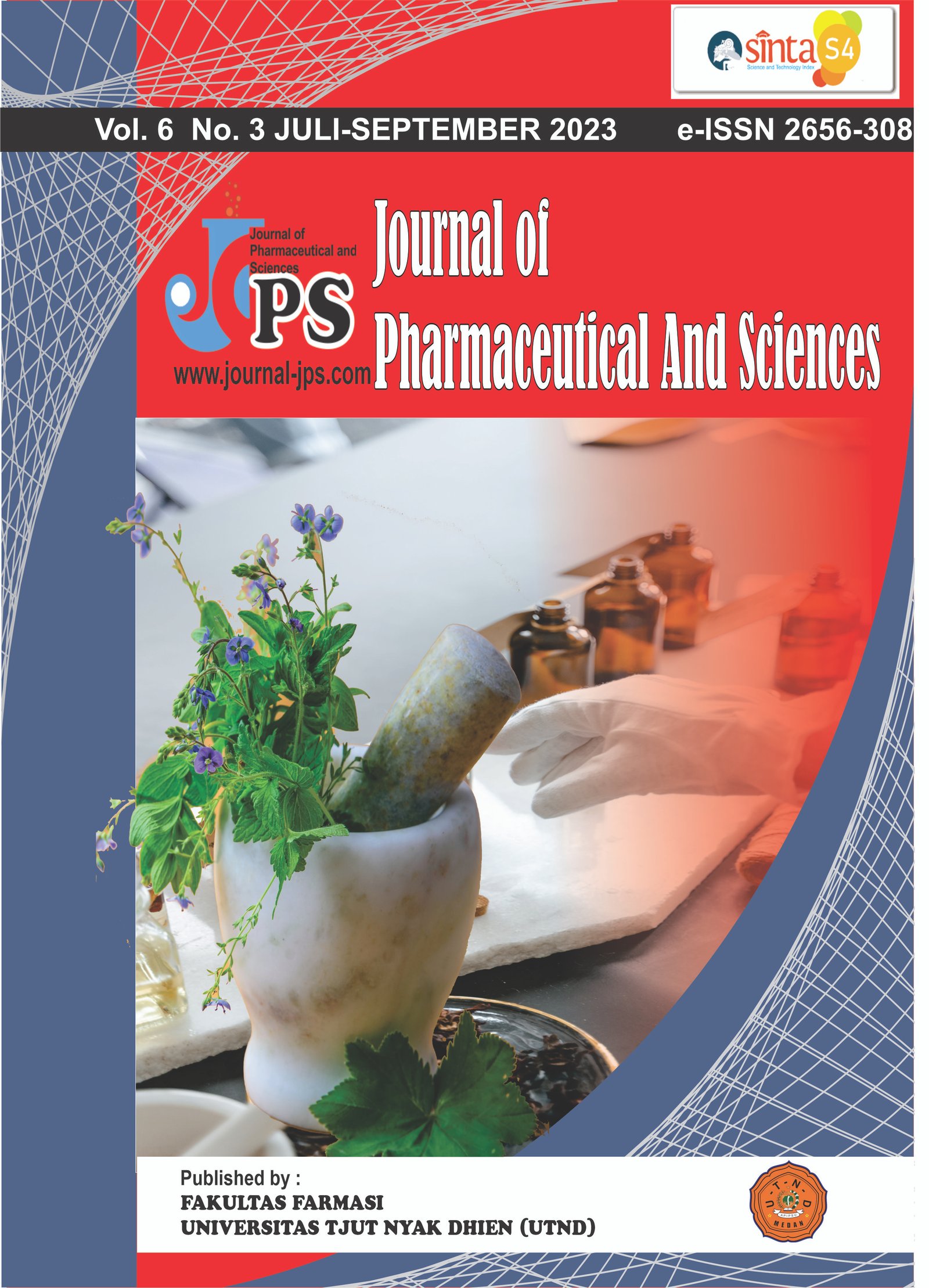Determination of total flavonoid content of ethanolic extract of yellow mangosteen (Garcinia xanthochymus) by spectrometry Uv-Vis method and LCMS
Main Article Content
Page: 935-950
Abstract
Background: Kandis acid fruit (Garcinia xanthocymus Hook. f ex T. Anderson) is a plant of the Clusiase family with many species. Kandis acid fruit has various biological and pharmacological activities such as cytotoxic, anti-inflammatory, antimicrobial, antifungal and antioxidant. Purpose: To determine the content and total flavonoid content of tamarind kandis using quercetin as a reference standard. Method: This study used the TLC (Thin Layer Chromatography) method in qualitative analysis with the parameter Rf, then used the spectrophotometric method in the quantitative analysis with the parameter total flavonoid content (Value of mg QE/g sample) and the LCMS method (Liquid Chromatography Mass Spectrometry) with the parameter retention time (Rt). Result: Shows that tamarind kandis has an Rf value of 0.86 which states that tamarind kandis is positive for flavonoids with a reference standard of quercetin, total flavonoid content of 34.8364 mg QE/g sample with a standard deviation of 0.4355 and a percentage of 0.6967% and has five types of flavonoid compounds namely methyl dihydro quercetin, 1,5-Dihydroxy-3-methoxy xanthone, Afzelechin, Myricetin-3-O-ß-D-galactopiranoside, and Myricetin 7-glucoside. Methyl dihydro quercetin is the largest flavonoid with a composition of 49.57% with a retention time of 0.485 minutes. Conclusion: The identified total flavonoids have different types and levels
Downloads
Article Details

This work is licensed under a Creative Commons Attribution-NonCommercial-ShareAlike 4.0 International License.
References
Akwu, N., Naidoo, Y., Singh, M., Thimmegowda, S. C., Nundkumar, N., & Lin, J. (2020). Isolation of lupeol from grewia lasiocarpa stem bark: Antibacterial, antioxidant, and cytotoxicity activities. Biodiversitas, 21(12), 5684–5690. https://doi.org/10.13057/biodiv/d211213
Aminah, A., Tomayahu, N., & Abidin, Z. (2017). Penetapan Kadar Flavonoid Total Ekstrak Etanol Kulit Buah Alpukat (Persea Americana Mill.) dengan Metode Spektrofotometri UV-Vis. Jurnal Fitofarmaka Indonesia, 4(2), 226–230. https://doi.org/10.33096/jffi.v4i2.265
Andry, M., & Winata, H. S. (2022). Uji Aktivitas Antibakteri Streptococcus Mutans serta Formulasi Sediaan Pasta Gigi Ekstrak Etanol Buah Okra Hijau (Abelmoschus esculentus) dan Tulang Ikan Tuna (Thunnini). Journal of Pharmaceutical and Sciences (JPS), 5(2), 170–173.
Asmorowati, H., & Lindawati, N. Y. (2019). Penetapan Kadar Flavonoid Total Alpukat (Persea americana Mill.) dengan Metode Spektrofotometri. Jurnal Ilmiah Farmasi, 15(2), 51–63.
Asnaashari, M., Farhoosh, R., & Farahmandfar, R. (2019). Preservation of gallic acid and methyl gallate on purified Kilka fish oil oxidation by Rancimat. Food Science and Nutrition, 7(12), 4007–4013. https://doi.org/10.1002/fsn3.1264
Hariadi, H., Andry, M., Nasution, M. A., & Sumiardi, A. (2023). Jurnal Biologi Tropis Growth Inhibition Test of Gram and Negative Bacteria in Pharmaceutical Biotechnology Products in the Form of Hand Sanitizer Formulations Based Fermented Telang Flower Kombucha. (2022).
Hidayah, N. (2018). Identifikasi Kandungan Senyawa Flavonoid Ekstrak Kulit Buah Jeruk Bali EKST (Citrus maxima Merr.) Secara Kromatografi Lapis Tipis. Jurnal Kesehatan Yamasi Makassar, 2(No.1).
K. Fitri, M. Andry, Khairani, T. N., Winata, H. S., A. Violenta, N. Lubis, & Lubis, M. F. (2023). Synthesis of Silver Nanoparticles Using Ethanolic Extract of Nelumbo nucifera Gaertn. Leaf and Its Cytotoxic Activity Against T47D and 4T1 Cell Lines. Rasayan Journal of Chemistrymistry, 16(01), 104–110. https://doi.org/10.31788/rjc.2023.1618000
Markham, K, R. (1988). Cara Mengidentifikasi Flavonoid (ITB). Bandung.
Muharni, dkk. (2011). Biflavonoid Coumpound From The Stem Bark Of Gamboge( Garcinia xanthochymus ). Indo.J.Chem, 11(2), 169–173.
Pambudi, D. B. dk. (2022). Efektivitas Farmakologi Senyawa Aktif Tumbuhan Mangrove. Jurnal Ilmiah Kesehatan, 15(1), 39–57.
Saewan, N., Mae, U., Luang, F., & Chantrapromma, K. (2015). Aktivitas anti-tirosinase dan anti-kanker dari flavonoid. Jurnal Penelitian Tanaman Obat, 5(6).
Satpute, M. S., Gangan, V. D., & Shastri, I. (2019). Synthesis and antibacterial activity of novel 3-hydroxy benzoic acid hybrid derivatives [Part II]. Rasayan Journal of Chemistry, 12(3), 1077–1084. https://doi.org/10.31788/RJC.2019.1235167
Saxena, V., & Yadav, K. (2020). Glycolic Acid, Lactic Acid, Mandelic Acid, Salicylic Acid, Citric Acid, Gluconolactone: Skin Exfoliators in Combination Therapy of Acne Vulgaris. International Journal of Research in Engineering, Science and Management, 3(10), 54–55. https://doi.org/10.47607/ijresm.2020.334
Semwal, D. K., Semwal, R. B., Combrinck, S., & Viljoen, A. (2016). Myricetin: A dietary molecule with diverse biological activities. Nutrients, 8(2), 1–31. https://doi.org/10.3390/nu8020090
Taheri, Y., Suleria, H. A. R., Martins, N., Sytar, O., Beyatli, A., Yeskaliyeva, B., … Sharifi-Rad, J. (2020). Myricetin bioactive effects: Moving from preclinical evidence to potential clinical applications. BMC Complementary Medicine and Therapies, 20(1), 1–14. https://doi.org/10.1186/s12906-020-03033-z
Winartiana. (2019). Metabolite Profiling Ekstrak Etanol 96 % Buah Prunus Persica (L) Batsch Berdasarkan Tingkat Kematangannya Menggunakan UPLC-QT of-MS/MS. Universitas Islam Negeri Maulana Malik Ibrahim Malang.
Winata, H. S., Andry, M., Nasution, M. A., Rezaldi, F., & Sembiring, A. S. F. B. (2023). Anti-Inflammatory Activity of Stem Barks Ethanol Extracts of Asam Kandis On Male White Rats. Journal of Agromedicine and Medical Sciences, 9(1), 47–53.
Yun Jung, S., Kim, H. J., Lee, J., Cho, J., Lee, Y. S., & Jin, C. (2012). Neuroprotective effects of quercetin 3-O-methyl ether, quercetin and (±)-Dihydroquercetin in a rat model of transient focal cerebral ischemia. Bulletin of the Korean Chemical Society, 33(7), 2443–2446. https://doi.org/10.5012/bkcs.2012.33.7.2443





